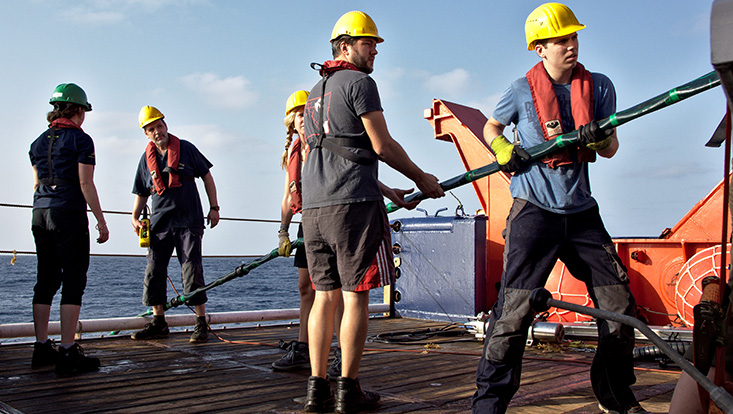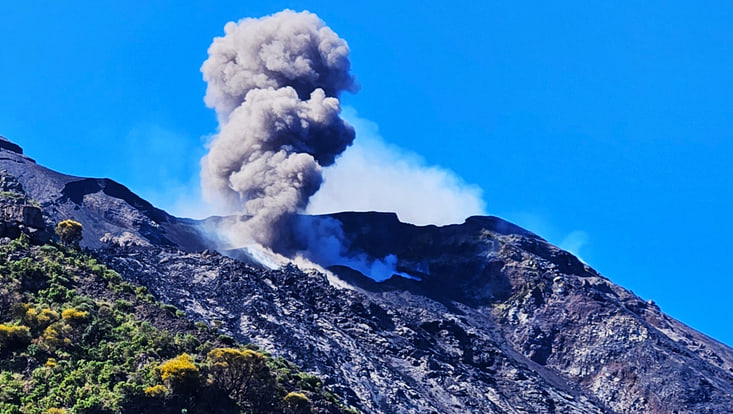Subterranean climate protectionStoring greenhouse gases in the depths of the Earth
27 July 2020, by Julika Doerffer, CEN Universität Hamburg

Photo: Jonas Preine/UHH
In order to limit global warming, in the future greenhouse gases will have to be removed from the atmosphere – it’s the only way to achieve climate targets. One way of doing so would be to permanently store carbon dioxide underground. However, geophysicist Prof. Christian Hübscher has repeatedly found problems and leaks at potentially suitable storage sites.
The European Union (EU) has committed to becoming climate neutral by 2050, in order to achieve the global climate goals laid out in the Paris Agreement. But it’s unlikely that it will manage to eliminate greenhouse gas emissions completely. According to the Federal Ministry for the Environment, emissions from aviation, agriculture and energy-intensive industries are likely to remain. In order to nevertheless meet the agreed-upon targets, the EU will have to rely on negative emissions technologies, which actively remove greenhouse gases like carbon dioxide (CO2) from exhaust gases and the air.
Permanent storage underground
A number of methods are already available, such as CCS – Carbon Capture and Storage. This involves capturing carbon, either directly in power plants or factories, or by using chemical processes to remove it from the surrounding air. The CO2 is then stored between layers of rock, deep underground.
Germany introduced carbon storage legislation in 2012, which regulates what will be permitted in the future and what won’t. It limits e.g. the total amount that can be stored in Germany every year to four million metric tons. Furthermore, there is a clause stipulating that individual federal states can largely decide for themselves how to apply the technologies. To date, Brandenburg is the only German state to have completed a research project concerning storage options. Mecklenburg-Vorpommern, Schleswig-Holstein and Lower Saxony have passed their own laws banning CO2 storage in their territories.
Nevertheless, Prof. Christian Hübscher still travels to these states. As a geophysicist, he conducts research at Universität Hamburg’s Center for Earth System Research and Sustainability (CEN). “Even though Germany’s northern states have decided against CO2 storage, we should still carefully investigate the underground conditions there,” Hübscher explains. “That way, we’ll be prepared if the topic is put back on the agenda.” In this article, Hübscher and his team present the findings of two new studies on Northern Germany and the Skagerrak region of the North Sea.
Glacial period and plate tectonics have shaken up the rocks
When it comes to storage, rock layers at a depth of 500 to 4,000 meters are the most suitable, e.g. porous rock or layers that are permeated by saltwater. These could be disused oil or gas fields or salt domes. However, they have to be tightly sealed from above, e.g. by a layer of mudstone. Christian Hübscher and his team are interested in studying such overlying strata. “In Northern Germany there are powerful natural geological processes at work, even though we normally hardly notice them. These can lead to faults and fissures in the rock that in some cases reach right up to the surface,” says Hübscher. “Many of these processes have been taking place since the end of the last glacial period and are still ongoing. However, at the moment we are focusing on the influence of plate tectonics.”

This aspect is causing the Eurasian and African Plates to move towards each other, opening up the Atlantic Basin. For Northern Germany this means, for instance, that the still-active, underground Glueckstadt Graben continues to affect large parts of Schleswig-Holstein. “We’ve recently identified a fresh fracture point in the east of the Graben, directly above a salt dome,” reports Hübscher. “Fluids and gases can rise up along the fracture. Any CO2 stored here could escape into the atmosphere through such a leak.” When it comes to selecting suitable CO2 storage sites, it’s vital to know about structures like this.
Pumping CO2 into the seabed?
CO2 could also be stored deep below the seabed: between Denmark and Norway, there is a sandstone layer at a depth of one to two kilometers that is considered to be suitable. Hübscher, together with his team, has closely examined this rock layer from on board the research vessel “Alkor.” Using special measurement techniques, they were able to show that gases escape from several small craters in the seabed there. They flow to the surface of the seafloor through fissures and fractures in the rock. If CO2 were stored there, it could escape along the same route into the sea. “Therefore, the overlying strata of any potential storage sites should be carefully examined for geological faults,” explains Hübscher. In his experience, it’s crucial to find the appropriate measurement method for each type of rock. Because it’s only by looking very carefully that you can determine whether or not CO2 can be stored securely there for many centuries to come.
Further information
Grob, Seidel and Hübscher (2020): Seismic amplitude and attribute data from Mesozoic strata in the Skagerrak (Danish-Norwegian North Sea): Indicators for fluid migration and seal bypass systems. Marine and Petroleum Geology, Vol. 121. Doi.org/10.1016/j.marpetgeo.2020.104596
Huster, Hübscher and Seidel (2020): Impact of Late Cretaceous to Neogene plate tectonics and Quaternary ice loads on supra salt deposits at Eastern Glückstadt Graben, North German Basin, International Journal of Earth Sciences, Vol. 109, 1029–1050, Doi.org/10.1007/s00531-020-01850-8
Frahm, Hübscher, Warwel, Preine, Huster, 2020: Misinterpretation of velocity pull-ups caused by high-velocity infill of tunnel 1 valleys in the southern Baltic Sea. Near Surface Geophysics, Doi.org/10.1002/nsg.12122
German law on carbon dioxide storage
Contact
Prof. Dr. Christian Hübscher
Universität Hamburg
Centrum für Erdsystemforschung und Nachhaltigkeit (CEN)
Tel: +49 (0) 40 42838 5184
Email: christian.huebscher"AT"uni-hamburg.de
Julika Doerffer
Öffentlichkeitsarbeit/Outreach
Universität Hamburg
Centrum für Erdsystemforschung und Nachhaltigkeit (CEN)
Tel: +49 (0) 40 42838 4237
Email: julika.doerffer"AT"uni-hamburg.de


